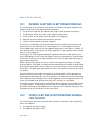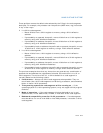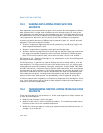
Vol. 3 17-29
8086 EMULATION
3. Clears the IF flag in the EFLAGS register to disable interrupts.
4. Clears the TF flag, in the EFLAGS register.
5. Locates the 8086 program interrupt vector table at linear address 0 for the 8086-
mode task.
6. Loads the CS and EIP registers with values from the interrupt vector table entry
pointed to by the interrupt vector number. Only the 16 low-order bits of the EIP
are loaded and the 16 high-order bits are set to 0. The interrupt vector table is
assumed to be at linear address 0 of the current virtual-8086 task.
7. Begins executing the selected interrupt handler.
An IRET instruction at the end of the handler procedure reverses these steps to
return program control to the interrupted 8086 program.
Note that with method 5 handling, a mode switch from virtual-8086 mode to
protected mode does not occur. The processor remains in virtual-8086 mode
throughout the interrupt-handling operation.
The method 5 handling actions are virtually identical to the actions the processor
takes when handling software interrupts in real-address mode. The benefit of using
method 5 handling to access the 8086 program handlers is that it avoids the over
-
head of methods 2 and 3 handling, which requires first going to the virtual-8086
monitor, then to the 8086 program handler, then back again to the virtual-8086
monitor, before returning to the interrupted 8086 program (see
Section 17.3.1.2,
“Handling an Interrupt or Exception With an 8086 Program Interrupt or Exception
Handler”).
NOTE
Methods 1 and 4 handling can handle a software interrupt in a virtual-
8086 task with a regular protected-mode handler, but this approach
requires all virtual-8086 tasks to use the same software interrupt
handlers, which generally does not give sufficient latitude to the
programs running in the virtual-8086 tasks, particularly MS-DOS
programs.
17.3.3.5 Method 6: Software Interrupt Handling
Method 6 handling is enabled when the VME flag is set to 1, the IOPL value is less
than 3, and the bit for the interrupt or exception vector in the redirection bit map is
set to 0. With method 6 interrupt handling, software interrupts are handled in the
same manner as was described for method 5 handling (see
Section 17.3.3.4,
“Method 5: Software Interrupt Handling”).
Method 6 differs from method 5 in that with the IOPL value set to less than 3, the VIF
and VIP flags in the EFLAGS register are enabled, providing virtual interrupt support
for handling class
2 maskable hardware interrupts (see Section 17.3.2, “Class
2—Maskable Hardware Interrupt Handling in Virtual-8086 Mode Using the Virtual
Interrupt Mechanism”). These flags provide the virtual-8086 monitor with an effi-


















